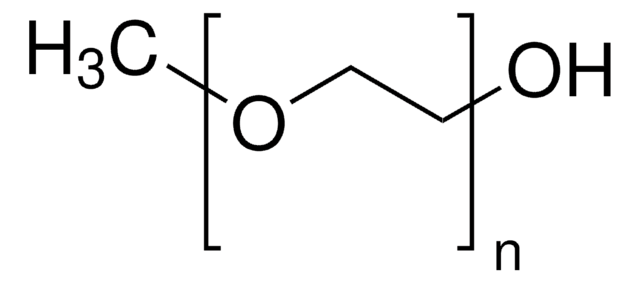732613
Poly(ethylene glycol) methyl ether
average MN 20,000, methoxy, hydroxyl
Sinônimo(s):
Polyethylene glycol, Methoxy poly(ethylene glycol), Polyethylene glycol monomethyl ether, mPEG
About This Item
product name
Poly(ethylene glycol) methyl ether, average Mn 20,000
densidade de vapor
>1 (vs air)
pressão de vapor
0.05 mmHg ( 20 °C)
forma
powder or crystals
peso molecular
average Mn 20,000
pf
64-69 °C
Mw/Mn
≤1.2
Ω-final
hydroxyl
α-final
methoxy
temperatura de armazenamento
−20°C
InChI
1S/C3H8O2/c1-5-3-2-4/h4H,2-3H2,1H3
chave InChI
XNWFRZJHXBZDAG-UHFFFAOYSA-N
Procurando produtos similares? Visita Guia de comparação de produtos
Aplicação
- Deoxycholic acid-grafted PEGylated chitosan micelles for the delivery of mitomycin C.: This study develops PEGylated chitosan micelles grafted with deoxycholic acid for effective delivery of mitomycin C, showcasing the potential of PEGylated compounds in pharmaceutical formulations and drug delivery systems (Zhang et al., 2015).
Código de classe de armazenamento
11 - Combustible Solids
Classe de risco de água (WGK)
WGK 1
Ponto de fulgor (°F)
359.6 °F
Ponto de fulgor (°C)
182 °C
Certificados de análise (COA)
Busque Certificados de análise (COA) digitando o Número do Lote do produto. Os números de lote e remessa podem ser encontrados no rótulo de um produto após a palavra “Lot” ou “Batch”.
Já possui este produto?
Encontre a documentação dos produtos que você adquiriu recentemente na biblioteca de documentos.
Os clientes também visualizaram
Artigos
Progress in biotechnology fields such as tissue engineering and drug delivery is accompanied by an increasing demand for diverse functional biomaterials. One class of biomaterials that has been the subject of intense research interest is hydrogels, because they closely mimic the natural environment of cells, both chemically and physically and therefore can be used as support to grow cells. This article specifically discusses poly(ethylene glycol) (PEG) hydrogels, which are good for biological applications because they do not generally elicit an immune response. PEGs offer a readily available, easy to modify polymer for widespread use in hydrogel fabrication, including 2D and 3D scaffold for tissue culture. The degradable linkages also enable a variety of applications for release of therapeutic agents.
Devising biomaterial scaffolds that are capable of recapitulating critical aspects of the complex extracellular nature of living tissues in a threedimensional (3D) fashion is a challenging requirement in the field of tissue engineering and regenerative medicine.
Nossa equipe de cientistas tem experiência em todas as áreas de pesquisa, incluindo Life Sciences, ciência de materiais, síntese química, cromatografia, química analítica e muitas outras.
Entre em contato com a assistência técnica
